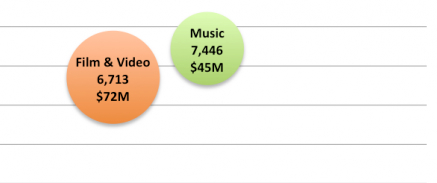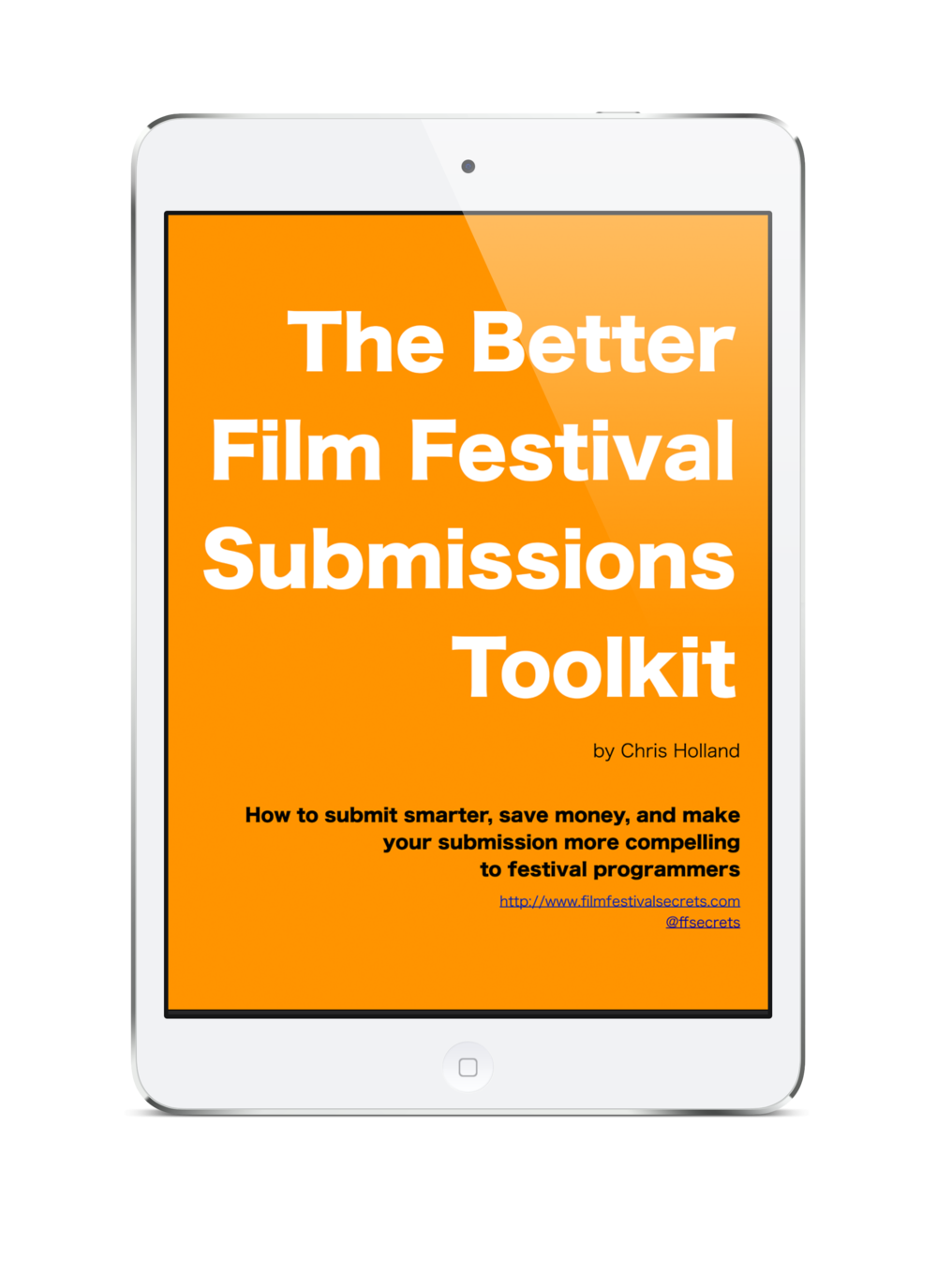What "Stripped" teaches us about the future of self-distribution and the marketing power of "Calvin & Hobbes."
This is the future of film distribution that "the industry" has anticipated in increasing degrees over the last decade: filmmakers creating quality content, cultivating an audience, and selling directly to that audience with as few middlemen as possible. The tools for this distribution model have been sneaking up on us but they finally seem ready for prime time. More importantly, there finally exists a critical mass customers who have the technology to watch movies this way -- and they seem perfectly fine "owning" just a digital file.
Time to add IndieFlix to the mix?
Recently I saw some smart messaging from IndieFlix. This 30 second spot acknowledges that Netflix is the reigning king of streaming entertainment on the mass media side, but it encourages movie lovers to expand their range of options to include indie films on the IndieFlix platform.
Streaming video revenue could eclipse US box office within the next 3 years
Rich McCormick writes a piece for The Verge about a new report from PricewaterhouseCoopers that predicts that streaming video services will make up 43% of the American film industry. Read on to learn where the revenue growth is coming from (spoiler: it isn't at the expense of movie theaters).
YouTube Is Ready for Its Close-Up
Veronica Mars digital download fiasco a depressing finish to a Kickstarter miracle
By now you've probably heard about the nasty fallout of the delivery of digital downloads to Veronica Mars backers: the disappointed fans and the offers of refunds to backers who ended up buying copies of the film from Amazon and iTunes. It speaks a lot to how much services like iTunes have become the default entertainment ecosystems and the fact that, if you want to try to buck that trend with a Veronica Mars-shaped Trojan horse, the execution had better be flawless.
Kickstarter's Year in Review for 2013
Kickstarter just posted this clever sub-section of their site that highlights some of the more remarkable Kickstarter-related moments and campaigns from the last twelve months. Stick with it to see the DeLorean Hovercraft and the human-powered helicopter.
What's the power of a dollar on Kickstarter? More than you think.
Asking for money is an awkward thing. When the answer is "yes" it's great, but when it has to be "no," well, even saying "that's OK" gracefully can add to the uneasiness.
To avoid this, when I ask friends for contributions to a Kickstarter campaign (as I have been doing every day for the last two weeks), I make it clear that I'm only asking for a dollar. That's it. If they want to give more, great. We have some great rewards that anyone anywhere who loves film festivals will enjoy. But really, one dollar will make me really happy. Giddy even. A $1 request makes it really easy for the askee to say yes (almost everyone can pitch in a buck) and that $1 pledge carries way, way more weight than a simple tweet or a like.
Here's why.
Film Festival Secrets Podcast #15 - Crowdfunding with Sundance Institute's Joe Beyer
Episode #15, in which Chris Holland talks crowdfunding with Joseph Beyer, Director of Digital Initiatives for the Sundance Film Festival & Institute. As one of the founders of Sundance's Artist Services program, Beyer has worked with Kickstarter on the successful funding of more than 90 crowdfunding campaigns, raising more than 2.8 million dollars since 2011. Joe now faces his biggest challenge in his first personal crowdfunding campaign — and because of the nature of the project, he can't use Kickstarter as his platform. Tune in for an informative and personal look at the technical, strategic, and emotional aspects of fundraising online.
Digital Tape is Dead: Bidding “Adieu” to the HDCAM (and its cousins)
7 Things You Absolutely Must Have On Your Film's Web Site
6 Reasons DVDs are dead as a festival submission format (or will be soon)
Economy, venue losses impact film festivals
A trio of articles crossed my desk this week that highlight the obstacles many small festivals face on the road to putting on a show.
The first is about the Vancouver International Film Festival, which will lose its main venue (a cineplex) in the coming year.
“When you have that really lovely centre of gravity and the dynamism around that, it makes it a pretty appealing event,” said [festival director Alan] Franey. “Whether we can find some magical way to create that energy, I have my doubts about that given available venues, so that’s a real loss.”
The second details similar venue woes for the Hot Springs Documentary Festival:
The event is being held at the Arlington Hotel this time around. That's because the Malco Theatre -- the festival's usual venue -- was damaged by a storm in August. Before that, Arvest Bank had filed a foreclosure suit on the theater.
Making matters worse, the festival board owes $20,000 in local taxes. But, the festival is bouncing back in style.
Finally and most disappointingly, the Lake Arrowhead Film Festival is suspending operations altogether, pending a financial comeback.
The festival, which had grown and evolved over the years, started to experience reduced funding in 2009 in the tanking economy.
"We so completely depend on our sponsors, and funding was cut way down," [festival director Mary] Dippell said.
The nonprofit had been turned down on about 50 grants and the effect was accumulative, she said.
"In 2012, we just had a fraction of the donations we usually have," Dippell said.
The festival scheduled for October 2013 has been called off.
Occasionally I hear from a filmmaker who assumes that festivals are universally rolling in dough from filmmaker submissions fees, or from someone who wants to start a festival, assuming that there isn't much to it. The reality differs from both of these perceptions – running a festival is serious business, and one shouldn't confuse "non-profit" with "doesn't need to make money."
On the festival venue front, I wonder how many small theaters will call it quits because they can't afford to make the jump from 35mm film to digital projection, and how many film festivals will lose their venues as a result.
Crowdfunding 201: Matthew Lillard Talks Campaign Secrets of 'Fat Kid'
Lucas McNelly, writing for The Huffington Post, asks director Matthew Lillard what he learned during his efforts to fund the film with Kickstarter donations.
...the big surprise for me has been how difficult it's been translating eyeballs and people loving the film into donations. I knew because of our exposure in the world, the social media numbers we have behind the project, that we'd be able to spike awareness around the film and I assumed that would mean we'd generate enough interest in our story to give money. That has not been the case. Facebook, Twitter, etc. is about awareness but it's been direct contact with people that's made the greatest impact on our campaign.
Based on what I've heard from filmmaker friends and what I've read in articles like these, the big lessons of Kickstarter are the same as the big lessons of any marketing effort. You need to know your audience really, really well, you need to offer them something they want, and you have to make it easy for them to participate. Kickstarter is great for the last part, but the other parts are up to you.
15 Film Festival Darlings That Would Have Been Better as TV Series
Evan Shapiro, writing for The Huffington Post back in January during Sundance:
Each year, there are a few great films that get Park City buzz, only to disappear into a sea of megaplexes and blockbusters. These are tweeners -- terrific stories, with great direction and unique characters that for various reasons are difficult to categorize and tricky to market. I submit that many of these would have fared better on TV. Would they have been better pieces of art? I cannot say. But with the reach and influence of cable TV right now, I can say they would have had a better chance of reaching an audience and influencing the culture, and their directors and producers may have seen a bigger return on their efforts.
It's an interesting read but it mostly makes me think of all of the independent filmmakers who bypass film festivals and go straight to their audiences with short serial content online. In years past these would be people who would have made films and submitted them to film festivals (and some of them still do, I'm sure), but now there's a generation of filmmakers being trained on YouTube instead of on the festival circuit.
Analyzing Kickstarter: What succeeds, by how much and how often

This piece by Michael Wolf, writing for GigaOm, should be of interest to those considering crowd funding their films with Kickstarter or IndieGogo. I was unaware of the "thirty percent rule," apparently observed by others before but restated and confirmed by Wolf:
Once projects get over the hurdle of 20 percent funding and reach 30 percent or more of their funding target, the chance of reaching the funding goal grows exponentially.
Also of interest is the fact that film and video projects are by far the largest category of funded projects, with music and design projects following up. Read the entire article on GigaOm.
The Frustrated Users of Withoutabox
![]()
Anthony Kaufman, writing for Indiewire:
in emails Withoutabox threatened participating Indee.tv festivals to "deactivate all third party submission services in order to avoid disruption to your Withoutabox service." And 10 festivals dropped the new service.
Reddy calls Withoutabox's exclusivity claims "ridiculous." "The tech industry would NEVER stand for this," he said, in an email. "Imagine Hotmail threatening to block access to your emails if you tried Gmail. The tech world will chew them to bits. Amazon knows this, but somehow feel like they can get away with bullying small festivals outside the tech world. They have a lousy product and rather than work on building a better one they stoop to these exclusivity clauses."
There are some interesting quotes from festival directors here about the problems they have with Withoutabox (WAB), the automated submissions system for filmmakers sending their films to film festivals.
As DC Shorts director Jon Gann points out in the article, this situation is unlikely to change until someone steps up to "challenge the goliaths." In this case, I think that means that a handful of prominent festivals (with typical annual submissions numbers upwards of 2000) would have to commit to using a different system. This will be accompanied by a blow to the number of submissions they receive, but introducing competition to the world of festival submissions might be worth it to them in the long run. The hard part of WAB's business to copy is its access to a large number of filmmakers with films ready to submit to fests. But if the only way to submit to some of the larger festivals were through an alternative solution, even that database of filmmaker prospects could be replicated over time.
(As an aside, I suspect that number of "400,000" filmmakers is mostly bogus. There may be 400,000 registered emails in the WAB system, but the chances that all – or even most – of those people are still actively submitting films to festivals is, in my humble estimation, pretty unlikely. It would have been nice to hear from a filmmaker or two in this article, since they are the people ultimately paying the bills.)
I think it's important to say here that, other than those emails enforcing the exclusivity clause, Withoutabox (WAB) isn't behaving in a particularly evil way. The people who work there are generally terrific and the service is the backbone of the film judging process. Unfortunately, WAB is a cog in the great Amazon/IMDb machine. Amazon is perfectly content to let that cog continue spinning as it has always spun, feeding other parts of Amazon's business. And without competition to threaten the way that cog spins, there is very little incentive to devote development resources to improving WAB's software, service, or pricing.
Regardless, festival staffers will likely continue their love/hate relationship with Withoutabox for some years to come. Here's one of my favorite rants from the festival perspective: the criminally under-watched "Bitch Fest" from Project Twenty1.
Should I Stay or Should I Go: The Rise of Cinema-on-Demand
Fest programmer Stephen Jannise, writing for the Austin Film Festival blog:
As far as we have come with on-demand movies, and as comfortable as most people have become with viewing films at home, the allure of the movie theater is still not lost on a majority of filmmakers. Playing in an actual cinema remains the ultimate dream, but the low costs and accessibility of VOD are so appealing to studios and distributors that this dream is even less likely to come true.
I think we'll see roughly as many indie features make it to screen as we ever have – for those films "worthy" of a big screen release, there is a definite correlation between a good run at the cinema and subsequent home video sales. However, with more indie films getting picked up for VOD distribution, the overall percentage of films that have theatrical distribution before they are made available to home audiences will shrink.
Sundance offers distribution "safety net" for its alumni
John Anderson at the New York Times:
a wormhole has opened up between Sundance Past and the Online Present. Through it, films seemingly lost in time — or swallowed up by the gaping maw of bad distribution deals, or no distribution deals — might find commercial redemption.
Thanks to a recent arrangement between the Sundance Institute, which operates the festival, and the Manhattan distributor New Video, six Web homes — Amazon, Hulu, Netflix, iTunes, YouTube and SundanceNOW — are making Mr. Noonan’s movie, and any other eligible Sundance film, available for streaming online. The option is open to every film ever shown at the festival, or brought to a Sundance lab, or given a Sundance grant. Filmmakers don’t surrender their rights. They (17 so far, with thousands of potential participants) can opt to go with any or all of the half-dozen sites. They have, in essence, a guaranteed means of distribution.
Read Sundance Offer New Video Streaming for Films - NYTimes.com.
Does Exclusive Content Matter?
Ashkan Karbasfrooshan at mediapost.com, writing about online video distributors like Hulu and Netflix:
Now don’t get me wrong, while content is king, monarchies are no longer in vogue; indeed the distributors have the power. Any producer that doesn’t “get this” is living in the past. But to ensure that advertisers keep the system running, distributors need to please viewers. To do that, you have to give viewers the content that they want when they want it.
The lesson is that producers are still paying the price for giving away too much, too easily, too fast. That kind of reputation is hard to shake. But once they realize they can have the upper hand if they play the game right -- then maybe, just maybe, they can get the diamond they deserve.
Read Does Exclusive Content Matter?.
(Via Amy Letourneau.)













